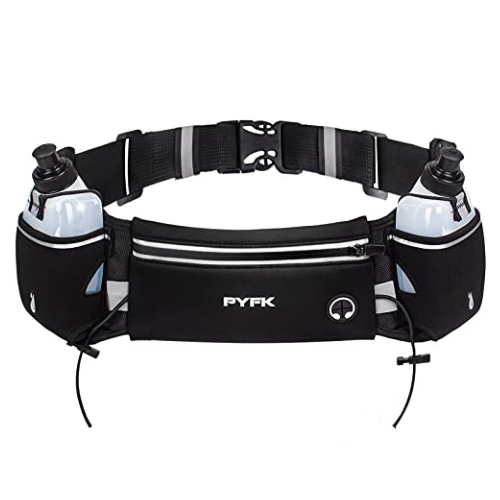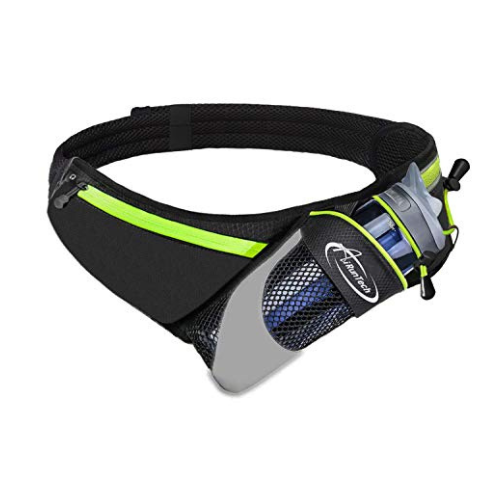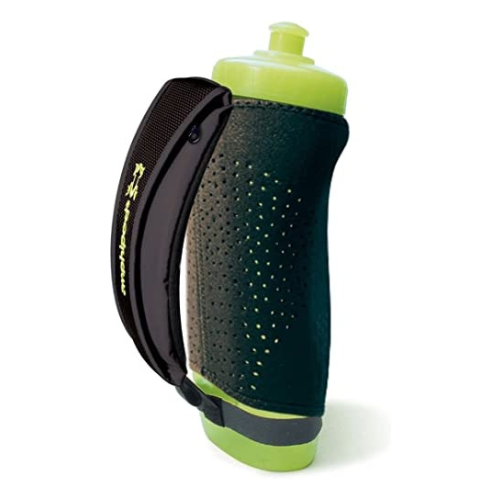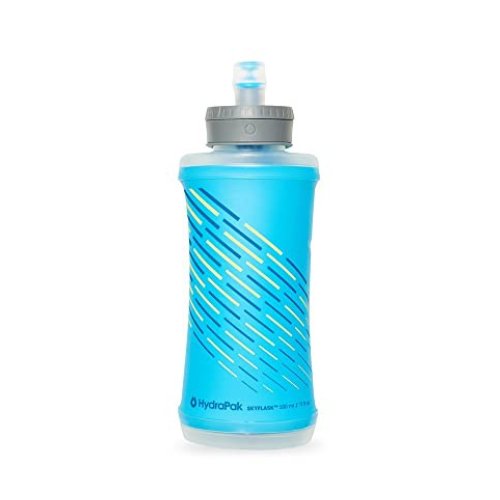5 Most Convenient Options to Carry Water While Running
Are you looking for ways to stay hydrated but don’t know how to carry water while running? Proper hydration is an essential part of any runner’s routine. Without it, runners can suffer from fatigue, dehydration, and heat exhaustion over short or long-distance runs.
In this blog post, we’ll discuss the various techniques and methods available to allow for carrying water while running – from handheld bottles to hydration belts and vests – along with tips on staying properly hydrated at all times.
So what is the best way to carry water while running? Find out how easy it can be to remain adequately hydrated during a run so you can stay active on any route!
How to stay hydrated while running?
Hydrating while running plays an essential role in managing fatigue and muscle recovery during workouts of any length. Appropriate gear such as soft flasks, waist packs, vests, and hydration backpacks can provide easy access to liquids and ensure constant hydration throughout exercise sessions.
Water while Running: Do You Need to Carry Water When You Run?
Running without consuming enough water can have serious risks for any runner, regardless of distance. Dehydration weakens muscles and causes cramps and fatigue, which in turn can affect speed and performance — slowing you down on both short and long runs.
It also leaves the runner vulnerable to heat exhaustion or heat stroke when running during the summer months, as well as cold-weather ailments such as frostbite in colder conditions.
It’s recommended to choose an electrolyte drink instead of plain water for enhanced performance when starting runs lasting more than an hour. These drinks contain sodium, potassium, calcium, and other minerals, which help replace lost electrolytes due to sweating.
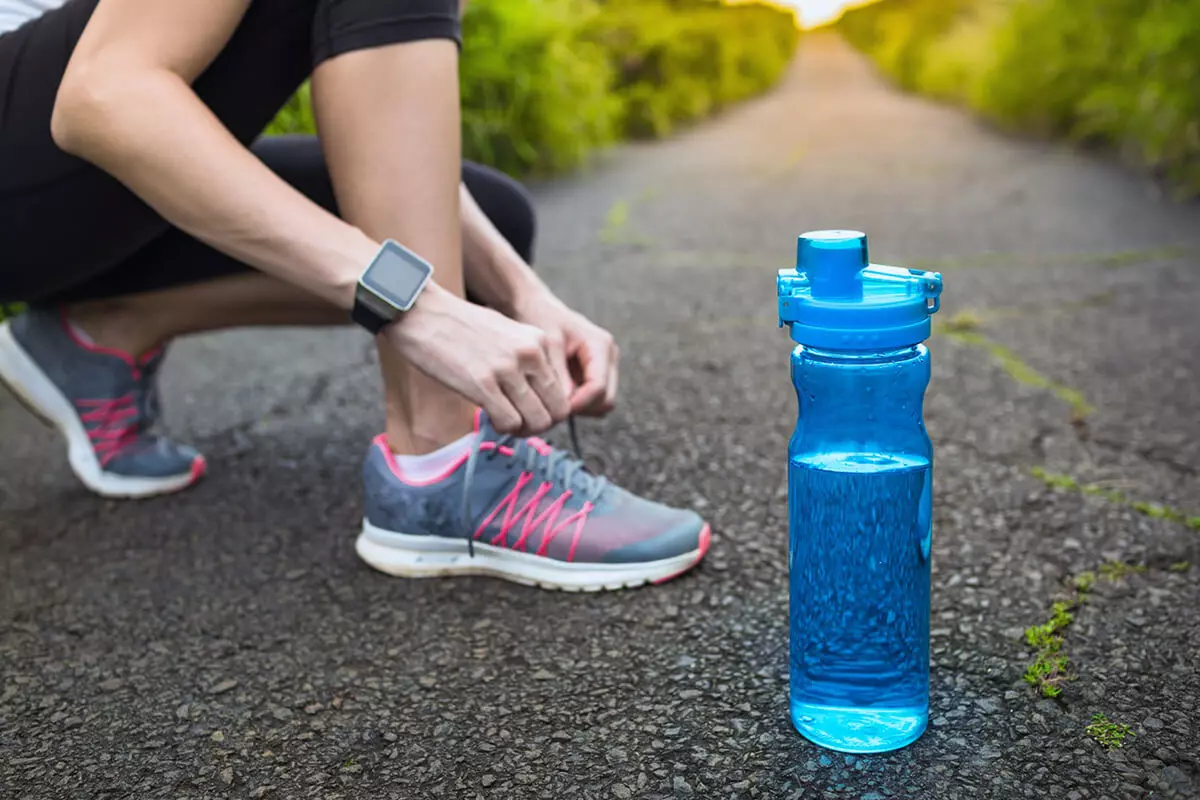
3 Benefits of Having Water While Running
Having water with you while running can provide increased energy, better recovery, and proper cooling. Let’s discuss the main benefits in more detail:
1. More Energy
Staying hydrated is vital for runners in order to maintain energy and performance levels. When you carry water while running, you provide your body with the hydration necessary to optimize muscle strength, thermoregulation, movement control, and mental clarity.
Additionally, drinking cold water or icy slush during exercise can further improve blood flow and extend running performance levels. Furthermore, drinking water instead of sugary drinks can ensure optimal metabolism of carbohydrates consumed pre-run, resulting in increased energy throughout workout time.
2. Better Recovery
Hydrating with water while running helps replenish lost fluids and aids in muscle recovery. Drinking plenty of water before a run allows the body to be better prepared to complete a run successfully. During exercise, water allows you to sweat and remove waste products from your muscles. After running, hydration is needed for recovery as well as restoring electrolytes which are essential for nerves and muscle function.
Staying hydrated can also improve blood flow throughout the body, allowing overall balance within your body’s internal system, resulting in increased performance gains and reduced potential for injury. Drinking fluids also supports joint health by providing lubrication, which lessens the risks of injury or further damage during exercise.
3. Proper Cooling
Proper cooling while running is essential for optimal performance and avoiding dehydration. It helps the body to regulate its temperature, preventing excessive sweating, which can lead to fluid loss and damage your health.
Not having access to cold water can increase the rate you sweat at by over 50%, leading to further dehydration, so carrying appropriate hydration equipment when running is essential for performance in hot weather conditions.
5 Options How to Carry a Water Bottle While Running
There are several options available to runners for a steady and convenient supply of water during long-distance runs. Keep reading to learn how to run with a water bottle.
1. Running Belt with a Water Bottle
Running belts are convenient and hands-free, leaving your arms free to move away from your body and preventing excessive sweating that would usually occur when carrying a heavier pack. They also have plenty of capacity, allowing you to store energy gels, snacks, phones, or other items needed for long runs as well as providing easy access.
Popular Choice
PYFK Upgraded Running Belt with Water Bottles
It’s a popular choice among runners for carrying their water on long runs. The belt sits securely at the waist and features adjustable straps, two 10 oz water bottles, additional storage pockets, and a reflective strip to help enhance visibility during low-light conditions.
The two bottles are positioned securely to prevent them from bouncing when running or walking. This lightweight and comfortable water belt also offers plenty of storage space for essential items such as smartphones, cash cards, and keys.
Pros:
- Bigger bottles for long runs
- Reflective line
- Convenient storage pockets
Cons:
- Some users find bottle straps too short to hold them securely during intensive runs.
Ultra-Light
Airuntech Upgraded No Bounce Hydration Belt
The Airuntech Upgraded no Bounce Hydration Belt is perfect for runners who want to carry their water with them but don’t want any unnecessary jostling or discomfort. This belt is designed with breathable Nylon and Lycra material which keeps the body cool and dry while running.
It comes in an ultra-light, durable design that allows you to securely store your phone, keys, and money without much bulk. The contoured shape of the 45-degree angle provides a snug fit to the body and prevents bouncing when you run.
Pros:
- Compatible with most bottles
- 45-degree angle for more comfort
- Fits all sizes
Cons:
- Some users experience excessive sweating under the belt.
2. Running Vest with Water Bottle
Hydration vests are designed to keep your hands free while allowing freedom of movement, so you can focus on your run without worrying about holding a bulky water bottle in your hands.
The capacity of these types of vests varies. Some are designed for short runs and just feature flasks or bottles, whereas more advanced models have both flasks and a larger space that allow for carrying much more liquid than handheld bottles or belts.
Flexible Design
TRIWONDER Hydration Pack Water Backpack
It comes with multiple storage options, such as a hydration bladder, tube, and pockets for other essentials such as a phone, wallet, and keys. Its flexible design allows it to be easily adjusted to fit your body type snugly and offers superior breathability thanks to its mesh construction that helps keep the user cool even on warm weather runs.
Pros:
- High-capacity bladder pocket
- Breathable, lightweight, and adjustable
- Has many pockets
Cons:
- Some users report issues while drinking through the water bladder tube.
3. Water Bottle for Running
Carrying a water bottle specifically designed for running is one of the easiest ways to ensure you stay adequately hydrated during your runs. These bottles usually come with ergonomic grips, wide mouths, and secure clips that let them be attached easily on waistbands or pocket straps (depending on size) so they can move with you as you go.
Easy Carrying
Amphipod Hydraform Thermal-Lite Handheld
Amphipod Hydraform Thermal-Lite Handheld is a lightweight water bottle designed for easy carrying on your runs. The insulated removable sleeve keeps liquids cold or hot for hours while running, making it perfect for all seasons and environments. This sleeve also has a small zipper pocket so you can store gels or keys while running without any inconvenience.
Pros:
- Leakproof
- Adjustable non-slip strap
- Reflective insulated sleeve, easy to remove and wash
Cons:
- The sleeve may get soaked in sweat, so it needs to be washed regularly.

4. Handheld Soft Flasks for Running
These water holders for runners are designed so that they collapse as you drink, preventing air from entering to reduce sloshing and minimizing bulkiness. Soft flasks are lightweight and convenient, making them a preferred option among athletes looking for easy access to hydration during their runs.
Reliable And Convenient
Nathan Exodraw & Exoshot 2.0 Flask
These flasks have been featured in numerous running competitions worldwide and remain some of the most reliable and convenient handheld containers for taking water on your runs.
Whether you’re looking for something small-sized like a 14 oz bottle, or a larger model, such as an 18 oz one with insulation benefits, there is sure to be one that suits your needs perfectly.
Pros:
- Ergonomically-designed hand strap for grip-free comfort
- Small pocket for essentials
- Adjustable, fits most sizes
Cons:
- The strap may be too stretchy for small hands.
Easy-To-Carry
Hydrapak Skyflask Lightweight Collapsible Handheld Running Water
The Hydrapak Skyflask is a lightweight, easy-to-carry, and collapsible running water bottle for any runner. It features an adjustable hand strap that enables hands-free hydration on the move.
Its spill proof cap prevents leaks during running, while the capacity of 16 oz makes it suitable for long-distance runs.
Pros:
- Easy to hold, adjustable strap
- Leak-proof
- Easy to clean
Cons:
- Some users report skin irritation caused by the strap.
5. Backpack for Water
How do runners carry water for ultra-long distances? A water backpack or hydration pack is a popular choice for runners looking to carry water while running. These backpacks are designed with a reservoir of water and straps to secure them comfortably onto the runner’s back, allowing them to access their hydration without having to break stride. They range from light vests that can be used in races right up to small full-featured backpacks that include compartments for other essentials such as energy gels, phones, and keys.
Best For Any Outdoor Enthusia
TETON Sports Trailrunner 2 Hydration Pack
It offers runners and outdoor enthusiasts a lightweight, efficient way to carry 70 oz of water. It weighs only 0.9 pounds dry and has dimensions of 16x10x3 inches, making it easy to take along on the road or trail without weighing you down.
The tube is equipped with a one-way quick-release straw that allows for easy access to hydration when you need it most.
Pros:
- Large front pocket
- 70 oz bladder included
- Durable and reflective
Cons:
- Needs regular rinsing and careful drying.
How Much Water Can You Drink While Running
The amount of water you should drink while running can vary significantly depending on the season and weather conditions.
In moderate temperatures, your best guide as a runner is simply your thirst signal. Pay attention to when you feel the need for a drink and try not to push through that feeling just because you have an idea in mind of what distance or speed goal you want to maintain.
Apart from seasonal fluctuations, drinking the right amount of fluids also depends on different factors such as the temperature, humidity level at race time, wind speed levels before and during a run as well as altitude changes which may affect body sweat rate during exercise intensity increases.
When running long distances (half-marathons or marathons), experts usually recommend bringing enough water since dehydration can be dangerous. Generally speaking, most runners should aim for anywhere between 7-10 fl oz every 10-20 minutes of actual running in warm conditions. However, some may require more or less according to individual needs.
How to choose the best water-carrying accessory for running: 3 Core factors to consider
When deciding on the best way to carry water during a run, several factors must be considered. It’s essential to choose the method of hydration that will most comfortably fit your needs and preferences.
For instance, what capacity is needed given the length or duration of the activity? Does it need additional features like compartments for storing other items? There are many options available, with handheld water bottles being one of the simplest and cheapest solutions. These can either be held in both hands as you run or passed from hand-to-hand every five minutes.

Pro Tip:
Waist packs such as running belts keep your hands free while preventing sweaty back issues. Hydration vests are also popular choices when carrying more water while on a run.
Let’s take a closer look at the main features to consider while choosing your water-carrying option.
1. Capacity
When considering what type of water-carrying solution is best for running, capacity is an essential factor to consider. The larger the capacity of the bottle or backpack being used, the more weight it will add to your run.
Too large of a capacity can overburden you and lead to uncomfortable strain on the arms if using a handheld bottle instead of a hydration pack. For shorter runs and cooler weather conditions, carrying smaller amounts may be more comfortable as you don’t need much liquid to replenish.

Pro Tip:
The core principle behind Fartlek training is to allow the body to adapt to various speeds while increasing its overall fitness. Both high-intensity and low-intensity sessions can be utilized in Fartleks for an extensive workout routine.
2. Fit
It’s crucial to choose a solution that fits comfortably and does not hinder the running motion or cause distraction or discomfort. The wrong type of gear may cause chafing, back pain, and decreased oxygen efficiency as it shifts during a run.
Besides, an adjustable waist pack with straps will offer more stability than just holding one bottle in a hand while running. Similarly, hydration vests can suit different body types by using adjustable straps so you can get the most secure fit without adding weight from belts and clips.
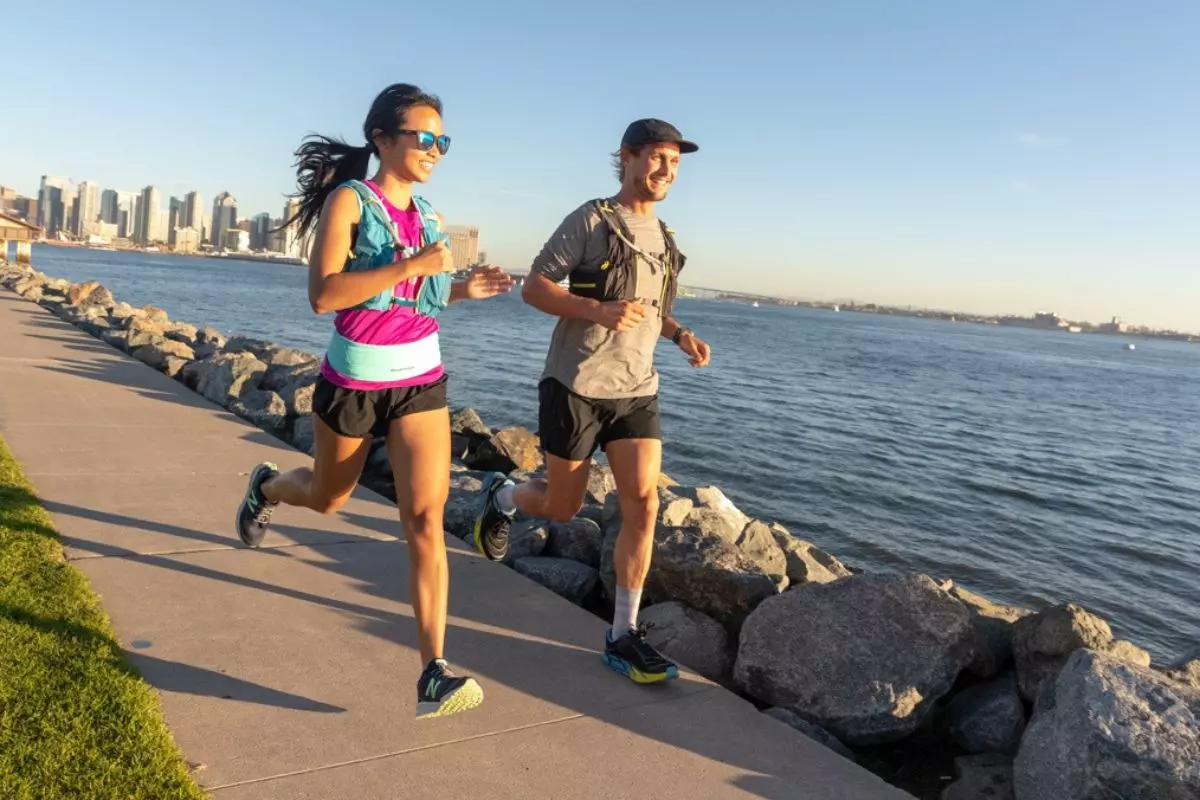
3. Additional Features
While the primary purpose of a water-carrying device for running is to make hydration easier and more accessible, there are other features available that can improve convenience, comfort, and safety.
For instance, having pockets or extra loops to hold snacks, clothes, or other items can be beneficial if desired. Reflective elements provide nighttime protection by making you visible from afar.
And adjustable straps enable personalized fitting based on body measurements or changing layers of clothing—all contributing to stability when carrying your chosen gear while running.
Subscribe to Our Running Newsletter!
Get free running tips from renowned professional athletes and discounts from top-notch brands.
Frequently Asked Questions about Running with Water
Where Should I Put My Water when Running?
When carrying water while running, it is essential to properly distribute the weight of the water so your running form is not affected. The best way to do this is by placing the weight on your back towards the center between your shoulders and hips – preferably with a hydration belt or pack, but also possible with a handheld water bottle if necessary.
Should I Carry a Water Bottle when Running?
Carrying a water bottle while running is essential to stay properly hydrated on all forms of runs. It’s important to stay hydrated even for shorter distances and during cooler weather, as dehydration can be very dangerous. A hand-held bottle can be an effective and convenient tool for short or medium runs.
What Is the Best Way to Hydrate During a Run?
Hydrating while running is essential for maximizing performance and preventing potential health issues. Hydration methods, such as handheld water bottles, running belts with water bottle holders, hydration vests, and backpacks, can make it easier to stay appropriately hydrated during a run.
Final Thoughts on Running with Water
Staying hydrated while running is essential to maintain energy levels and reduce the risk of heat-related illnesses. Drinking water while running can be difficult, but there are some tips on how to bring water on a run and various options available for runners depending on their needs and preferences.
From hand-held bottles to vests with plenty of storage, knowing the best way to carry water while running will ensure that you can stay hydrated and healthy during each run. A good option may depend on the amount of liquid you need as well as the duration, terrain, or conditions you plan to tackle when out running.
Having enough liquid without feeling weighed down makes it possible for successful runs every time, whether long distance or just out jogging.
What gear do you prefer for carrying water while running? Please share your experience in the comments below.
Also read:
- Best Muscle Massage Gun for Runners
- Chills After Running
- Why Throat Hurts After Running
- Bodybuilding and Running
- Best Running Visors
- Banana Before Run
- 8 Week 10K Training Plan
- How Many Minutes Is 2 Miles
- 6 Week 10K Training Plan
References:
- Water intake after dehydration makes muscles more susceptible to cramp but electrolytes reverse that effect // BMJ Open Sport & Exercise Medicine: https://bmjopensem.bmj.com/content/5/1/e000478
- Dietary Reference Intakes for Water, Potassium, Sodium, Chloride, and Sulfate // National Academies: https://nap.nationalacademies.org/catalog/10925/dietary-reference-intakes-for-water-potassium-sodium-chloride-and-sulfate
- Exercise – the low-down on hydration // Better Health Channel: https://www.betterhealth.vic.gov.au/health/healthyliving/Exercise-the-low-down-on-water-and-drinks
- National Athletic Trainers’ Association Position Statement: Fluid Replacement for Athletes // PMC: https://www.ncbi.nlm.nih.gov/pmc/articles/PMC1323420/
- Exercise and Fluid Replacement // ACSM’s Health & Fitness Journal: https://journals.lww.com/acsm-healthfitness/Fulltext/2013/07000/Exercise_and_Fluid_Replacement__Brought_to_you_by.3.aspx
- Hydration for Athletes // FamilyDoctor.org: https://familydoctor.org/athletes-the-importance-of-good-hydration/
If you have any questions or suggestions, you can contact us via email – [email protected]

